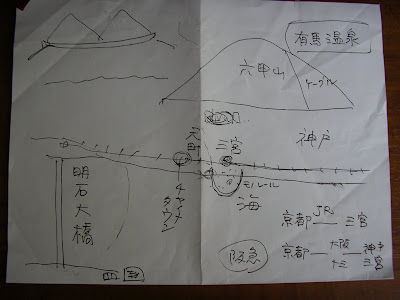Occurring only once per year, Takigi Noh is a special performance of the ancient Japanese Noh theater. Kyoto's Heian Shrine serves as a magnificent backdrop for the evening's dramatic performance, drawing a crowd of several thousand. Because Otousan and I arrived over 3 hours early, we were able to get excellent seats in the 2nd row, but even with an hour to wait before the performance began, all available seating and standing room had quickly filled up. This did not stop the continual announcements requesting that we please take up as little space as possible
as more people continued to squeeze into the shrine.

Although it was crowded, the weather could not have been more perfect. Pleasantly warm with a refreshingly cool breeze, everyone relaxed, chatting with each other in anticipation of the show. Many people had brought a bento to snack on during the wait. As the sun began to go down, Shinto priests set on fire three large piles of firewood and several smaller braziers surrounding the stage, continuing to refuel them throughout the night to provide lighting for the performance.

Developed in ancient times by courtiers and performed by the cultural high class of Japan, Noh is known for it's attention to minute detail and subtlety; the slightest reach of a hand, turning of the head, or movement of the body is almost always significant. However, the plots were not overly complicated and armed with my English summaries, I was able to follow along quite easily. The Takigi Noh performance is composed of a set of plays separated by short intermissions. Traditionally, one of the intermissions is filled with Kyogen, a comedic and less stylized theatrical art form. This night was no exception. The Kyogen story revolved around a servant whose master had sent him on an errand to deliver sake. The servant encountered and old friend who managed to convince him to drink the sake instead. Both men became drunk and hilarity ensued.
The Kyogen was amusing, but the final Noh performance was perhaps the most exciting. The story, set in China, revolved around three lions who guarded an ancient and special bridge. The lions, dressed in fantastically ornate costumes and masks (the original suGOku kirei
), ran and jumped fiercely around the stage, sometimes frantic with sudden gestures and movements, stomping on the floor for emphasis. At the peak of story, as the 12-man chorus reached it's loudest volume yet and the complex rhythms of the Otsuzumi and Kotsuzumi drums rang out into the night air, with the firelight dancing across the stage, one of the actors (in full lion-kimono regalia) did a standing backflip over one of the other actors. It was a suitably dramatic ending for a night whose atmosphere of excitement and enjoyment was unforgettable.






